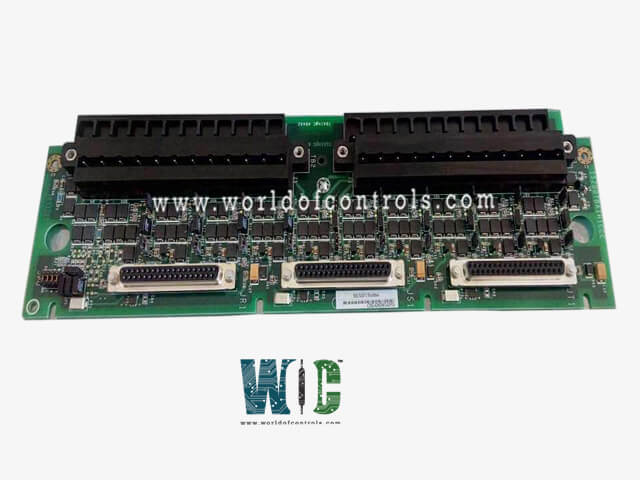
World Of Controls understands the criticality of your requirement and works towards reducing the lead time as much as possible.
IS200TBQFH2A - 16-Channel Analog Input Termination Module is available in stock which ships the same day.
IS200TBQFH2A - 16-Channel Analog Input Termination Module comes in UNUSED as well as REBUILT condition.
To avail our best deals for IS200TBQFH2A - 16-Channel Analog Input Termination Module, contact us and we will get back to you within 24 hours.
SPECIFICATIONS:
Part Number: IS200TBQFH2A
Manufacturer: General Electric
Series: Mark VIe
Product Type: 16-Channel Analog Input Termination Module
Number of channels: 16
Power supply voltage: 28 V DC
Voltage Range: 18 - 32 VDC
Mounting: DIN-rail mounting
Technology: Surface mount
Operating temperature: -25 to 70°C
Size: 33.02 cm high x 17.8 cm
Repair: 3-7 days
Availability: In Stock
Country of Origin: United States
FUNCTIONAL DESCRIPTION:
IS200TBQFH2A is a 16-channel Analog Input Termination Module manufactured and designed by General Electric as part of the Mark VIe Series used in GE Distributed Control Systems. The 16-Channel Analog Input Termination Module is engineered to interface field analog signals with a centralized control or monitoring system, typically within Distributed Control Systems (DCS) or Programmable Logic Controllers (PLC). Each of the 16 channels provides an independent termination point for analog inputs such as 4–20 mA current loops, 0–10 VDC signals, or thermocouples and RTDs, depending on the signal conditioning design.
The module offers high-density connectivity and ensures signal integrity through optimized PCB layout and minimized crosstalk. Designed for robust industrial environments, it incorporates protection components such as transient voltage suppressors, current-limiting resistors, and isolation circuitry to safeguard connected systems against electrical noise, surges, or grounding inconsistencies. Channel identification and test points are marked, allowing for rapid diagnostics and streamlined maintenance. Signal conditioning elements (if integrated) may include filtering, linearization, and cold-junction compensation.
INSTALLATION:
The 16-Channel Analog Input Termination Module is designed for quick and secure installation within industrial control cabinets. It should be mounted on a standard DIN rail or securely fastened to a backplate, ensuring sufficient clearance for ventilation and cable management. Field analog signals, such as 4-20 mA loops, voltage signals, or sensor outputs, must be connected to the respective input terminals using shielded twisted-pair cables to minimize electrical noise and interference. Proper termination practices, including correct polarity and grounding, are essential to ensure signal integrity. The shield of the cable should be connected to a designated ground point to prevent EMI-related issues. Once the field wiring is complete, the module is interfaced with the analog input card of the DCS or PLC using a multi-pin connector or ribbon cable, following manufacturer-recommended cable routing guidelines to avoid signal coupling from power lines or other high-voltage sources. Before system startup, a thorough inspection and verification should be performed using a multimeter or signal simulator to ensure continuity, correct wiring, and proper operation of all input channels.
OPERATION:
The 16-Channel Analog Input Termination Module passively facilitates the transmission of analog signals from field instruments to the analog input interface of the host control system. The module ensures:
WOC maintains the largest inventory of GE Distributed Control System (DCS) replacement parts, offering both new and professionally rebuilt components, each backed by a comprehensive warranty. Our 24/7 technical experts are ready to support all your automation needs, providing prompt assistance with part availability, pricing, repairs, and system upgrades. With a focus on rapid response, quality assurance, and tailored solutions, we help you maximize the performance and reliability of your GE DCS systems. Contact us via phone or email for immediate, professional support.
What is the function of a 16-channel analog input termination module?
This module provides a structured interface for connecting up to 16 analog input signals from field devices (such as transmitters or sensors) to a control system like a DCS or PLC. It facilitates signal organization, conditioning (if applicable), and wiring integrity.
What types of analog signals does this module support?
It typically supports industry-standard analog signals such as 4-20 mA, 0-10 VDC, 1-5 VDC, and, in some configurations, thermocouple or RTD inputs, depending on the design.
What is the recommended wiring specification?
Use shielded twisted-pair (STP) cables rated for low-level analog signals (typically 22-24 AWG). The shield should be grounded at the control panel side to minimize common-mode noise. Cable routing must observe separation from power lines per IEEE 518 guidelines.